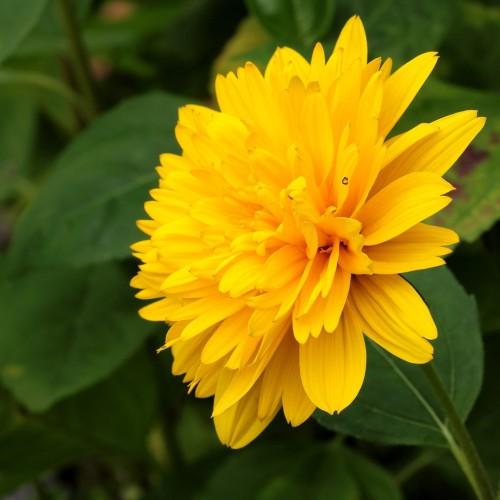
sunflower
Helianthus 'Sunshine Daydream'
Cycle:
Herbaceous Perennial
Watering:
Average
Hardiness Zone:
4 - 8
Flowers:
Flowers
Sun:
Full sun
Leaf:
Yes
Growth Rate:
High
Maintenance:
Low
Drought Tolerant:
Yes
Salt Tolerant:
Yes
Care Level:
Medium
watering
For the sunflower (Helianthus 'Sunshine Daydream'), water thoroughly 1-2 times per week, as needed. The soil should be kept consistently moist but not overly saturated. Allow the top inch or 2 of soil to dry out before watering again. During the hottest months of summer, you may need to water more often. It is also important to ensure that the sunflower is not receiving too much water, as this can cause the roots to rot. Provide mulch around the base of the plant to help retain moisture in the soil.
sunlight
Sunflower (Helianthus 'Sunshine Daydream') will thrive in full sun, meaning 6 to 8 hours of direct sunlight each day. For optimal growth and bloom production, sunshine should be provided during the growing season, typically between the months of April and October. Sunflowers should be planted in a spot that gets direct sunlight each morning. Avoid spots that are in the shade, as this will stunt the growth of the plant and limit bloom.
pruning
Sunflower (Helianthus 'Sunshine Daydream') should be pruned after the flowering period. Most sunflowers should be pruned back after blooming to encourage a second flush of blooms. Prune back the stem to just above the first set of leaves after the bloom has finished. Remove any dead, diseased or damaged stems or leaves and discard. Take care not to remove more than 1-third of the plant's live growth. This will help promote a strong, healthy, and beautiful second blooming in the fall.
FAQ
Are sunflower seeds edible?
Yes, sunflower seeds are edible and are enjoyed around the world. Sunflower seeds have a nutty flavor and can be eaten either raw or roasted. Popular forms of eating sunflower seeds include tossing them in salads, sprinkling them in stir fry dishes, using them as an ingredient in baked goods, and snacking on them as a healthy and tasty snack. Sunflower seeds are available both with and without their shells, depending on the preference of the consumer.
Are there any pests that commonly attack sunflowers?
Yes, there are several pests that commonly attack sunflowers, such as European corn borer, aster leafhoppers, cabbage loopers, and potato leafhoppers. These pests can all cause significant damage to the plant, such as wilting of the leaves, stunted growth, and loss of petals. Preventative measures, such as proper maintenance and pesticides can help reduce their numbers and damage to the sunflowers.
Are sunflowers an annual or perennial plant?
Sunflowers are an annual plant, meaning they will only live for one growing season. This typically falls within the summer months as sunflowers will reach maturity within two to three months after planting. They will typically flower and then die off before the following season, making them an annual plant.
Could sunflowers grow in a greenhouse or indoor garden?
Yes, sunflowers can be grown in a greenhouse or indoor garden. Sunflowers require bright, direct light, but if a greenhouse or indoor garden is equipped with special lighting, sunflowers can grow successfully. When growing them indoors, it is important to ensure that the soil is well-drained and that they are getting the appropriate amount of light, water and nutrients. When the conditions are right, even the tallest varieties of sunflowers can be successfully grown indoors.
Should sunflowers be planted in the spring or fall?
Sunflowers should be planted in the spring, as soon as the last frost has passed and the soil is warm. Planting in the spring ensures that your sunflowers get plenty of heat and sunshine to spur growth and yield beautiful blooms. In more northern climates, however, you might need to stagger your planting dates over the spring so that they are not all exposed to extreme cold.
How long does it take for a sunflower to bloom?
Sunflowers have a relatively short blooming season, typically lasting only a few weeks. After pollination, the flower buds will typically form within 5-10 days and open up within 8-12 days. This means a sunflower can take anywhere between 8 and 20 days to bloom after pollination. Factors such as genetics, soil temperature, and light availability can influence the amount of time it takes a sunflower to bloom.
Do sunflowers attract bees and butterflies?
Yes, sunflowers are very attractive to bees and butterflies. Sunflower petals offer a generous amount of nectar, providing an excellent food source for these pollinators. Sunflowers also offer protection from predators and the elements for the bees and butterflies. The bright yellow color of the sunflower petals are also visually appealing to these insects, drawing them in from miles away!
Is the sunflower a symbol of happiness?
The sunflower is often associated with happiness and joy, usually because of its bright yellow petals and attractive appearance. Sunflowers can also be seen as symbols of loyalty and warmth, as they have a tendency to always follow the sun and turn towards the light. The sunflower is often used as a representation of faith or loyalty, and its natural beauty can provide us with a sense of joy and optimism.
